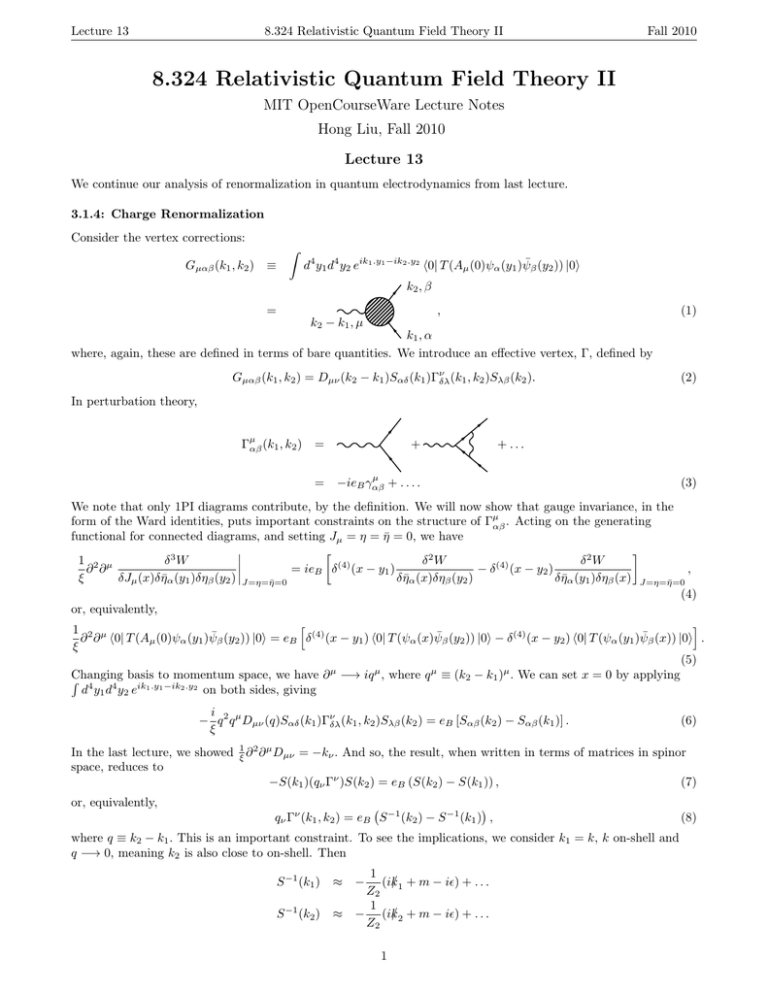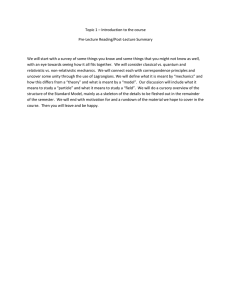Document 13650482
advertisement

Lecture 13 8.324 Relativistic Quantum Field Theory II Fall 2010 8.324 Relativistic Quantum Field Theory II MIT OpenCourseWare Lecture Notes Hong Liu, Fall 2010 Lecture 13 We continue our analysis of renormalization in quantum electrodynamics from last lecture. 3.1.4: Charge Renormalization Consider the vertex corrections: ˆ Gµ�� (k1 , k2 ) ≡ d4 y1 d4 y2 eik1 .y1 −ik2 .y2 ⟨0| T (Aµ (0)ψ� (y1 )ψ̄� (y2 )) |0⟩ k2 , β = , k2 − k1 , µ (1) k1 , α where, again, these are defined in terms of bare quantities. We introduce an effective vertex, Γ, defined by Gµ�� (k1 , k2 ) = Dµδ (k2 − k1 )S�� (k1 )Γδ�β (k1 , k2 )Sβ� (k2 ). (2) In perturbation theory, Γµ�� (k1 , k2 ) = + + ... µ = −ieB γ�� + .... (3) We note that only 1PI diagrams contribute, by the definition. We will now show that gauge invariance, in the µ form of the Ward identities, puts important constraints on the structure of Γ�� . Acting on the generating functional for connected diagrams, and setting Jµ = η = η̄ = 0, we have [ ] 1 2 µ δ3 W δ2W δ2W (4) (4) − δ (x − y2 ) ∂ ∂ = ieB δ (x − y1 ) , ξ δJµ (x)δη̄� (y1 )δη� (y2 ) J=α=ᾱ=0 δ η¯� (x)δη� (y2 ) δη̄� (y1 )δη� (x) J=α=ᾱ=0 (4) or, equivalently, [ ] 1 2 µ ∂ ∂ ⟨0| T (Aµ (0)ψ� (y1 )ψ̄� (y2 )) |0⟩ = eB δ (4) (x − y1 ) ⟨0| T (ψ� (x)ψ̄� (y2 )) |0⟩ − δ (4) (x − y2 ) ⟨0| T (ψ� (y1 )ψ̄� (x)) |0⟩ . ξ (5) µ µ µ µ Changing basis to momentum space, we have ∂ −→ iq , where q ≡ (k − k ) . We can set x = 0 by applying 2 1 ´ 4 d y1 d4 y2 eik1 .y1 −ik2 .y2 on both sides, giving i − q 2 q µ Dµδ (q)S�� (k1 )Γδ�β (k1 , k2 )Sβ� (k2 ) = eB [S�� (k2 ) − S�� (k1 )] . ξ (6) In the last lecture, we showed 1η ∂ 2 ∂ µ Dµδ = −kδ . And so, the result, when written in terms of matrices in spinor space, reduces to −S(k1 )(qδ Γδ )S(k2 ) = eB (S(k2 ) − S(k1 )) , (7) or, equivalently, ( ) qδ Γδ (k1 , k2 ) = eB S −1 (k2 ) − S −1 (k1 ) , where q ≡ k2 − k1 . This is an important constraint. To see the implications, we consider k1 = k, k on-shell and q −→ 0, meaning k2 is also close to on-shell. Then S −1 (k1 ) S −1 (k2 ) 1 (ik/ + m − iϵ) + . . . Z2 1 1 ≈ − (ik/2 + m − iϵ) + . . . Z2 ≈ − 1 (8) Lecture 13 8.324 Relativistic Quantum Field Theory II Fall 2010 where m here is the physical mass. We then have qδ Γδ (k, k) = − eB i/q, Z2 (9) or ieB δ γ Z2 when k is on shell. The physical charge we measure should be Γδ (k, k) = − (10) k Γµphys (k, k) = µ ≡ −iephys γ µ . k (11) where k is on-shell and we are using the physical fields. In other words, consider ˆ G(µphys) (k1, k2 ) = d4 y1 d4 y2 eik1 .y1 −ik2 .y2 ⟨0| T (Aµ (0)ψ� (y1 )ψ̄� (y2 )) |0⟩ (12) where the fields are now the physical fields, rather than the bare fields. Then G(µphys) (k1 , k2 ) = Dµδ (q)S(k1 )Γδphys (k1 , k2 )S(k2 ) where Dµδ and S are again here for the physical fields. Since √ √ B AB Z3 Aµ , Dµδ = Z3 Dµδ , ψ B = Z2 ψ, S B = Z2 S, µ = we have that GB µ = √ √ Z3 ( Z2 )2 G(µphys) , e= √ (14) (15) where GB ≡ DB S B ΓB S B and G(phys) = DSΓ(phys) S. From this, we have that √ Γδ (k, k) = Z3 Z2 ΓδB (k, k) and so (13) (16) Z3 eB . (17) √ The dependence of e on Z2 cancels precisely as a result of ΓB ∝ That = Z3 only depends on Z3 , the field strength renormalization of the photon, has important implications: the ratio is universal for all charged fields. electron Suppose that eproton = eB . Then it is necessarily true that eproton = eelectron , despite the proton and electron B interacting very differently and having different masses. If eeB depended on Z2 , for example, then we would have an extremely difficult time in explaining why eproton = eelectron , as their respective values of Z2 are very different. Finally, in terms of renormalized quantities: [ ] qδ Γδ (k1 , k2 ) = e S −1 (k2 ) − S −1 (k1 ) . (18) eB Z2 . e eB We note additionally that for k1 and k2 on-shell, but k1 ̸= k2 , qδ Γδ (k1 , k2 ) = 0. (19) This is an example of a large class of identities. These are known as the general Ward identities. These identities are obtained by acting on the generating functional for connected diagrams with δ δ δ δ δ δ ... ... ..., δJδ1 (z1 ) δJδ2 (z2 ) δη̄(y1 ) δη̄(y2 ) δη(x1 ) δη(x2 ) and then setting Jµ = η̄ = η = 0. The resulting expression is most transparently written diagramatically in momentum space: kµ pr qn pr qn pr qn . .. .. .. .. .. ∑ .. . . . . . = eB qi − k − pi + k p2 q2 .. .. i p2 q2 . . p1 q1 p1 q1 p1 q1 2 (20) (21) Lecture 13 8.324 Relativistic Quantum Field Theory II Fall 2010 where each external line should be considered as an exact photon or fermion propagator, except that associated with kµ on the left-hand side, which should be amputated. Remarks: 1. Suppose we attach to Γµ a photon propagator at the q δ . If all the external propagators are on-shell, the longitudinal part of the propagator does not contribute as the inner product of this with q δ is zero. This enforces gauge invariance. 2. Suppose we attach to Γµ an external photon line, that is, ϵµ Γµ (k, . . .). This is invariant under ϵµ −→ ϵµ + kµ , which is a gauge transformation Aµ −→ Aµ + ∂µ Λ. 3. Only charged particles need to be on-shell. Other photon lines or any other neutral particles (if they exist) can be off-shell, since they they do not transform under gauge transformations. 4. For Ward identities to be valid, regularization should preserve gauge invariance. 3 MIT OpenCourseWare http://ocw.mit.edu 8.324 Relativistic Quantum Field Theory II Fall 2010 For information about citing these materials or our Terms of Use, visit: http://ocw.mit.edu/terms.







